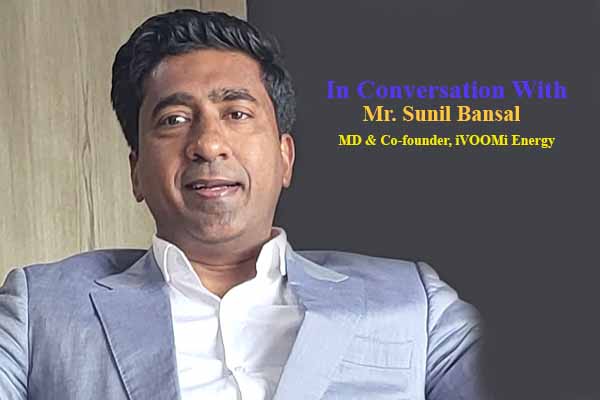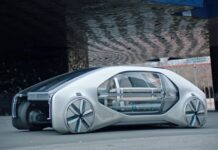Several new technological developments are being made in the EV segment to make them as convenient and efficient as ICE vehicles. Mr. Sunil Bansal, MD and Co-founder of iVOOMi Energy tells TimesTech how the different technology available are selected and developed for deployment in EVs and many new facts related to it.
Read the full interview here:
TimesTech: What are the different types of EV batteries currently available for production and which are the most efficient?
Sunil: As the world is wholeheartedly accepting sustainable and green energy, numerous companies and brilliant minds across the world are developing viable technology everyday.
Although today, commercial availability along with mass production capabilities, there are only 3 to 4 electro chemistries available.
NMC/NCA and LPF are the two most widely accepted and reliable batteries being deployed.
Within these electrochemistry, different form factors and makes are available, which is towards battery pack design, availability, and cost acceptance in the market.
TimesTech: What are the limitations of the batteries currently being used in electric vehicles?
Sunil: Defining battery limitations will depend on the demand or feedback that the manufacturers get from the market. It can vary in different scenarios such as day-to-day travel needs and the distance to be covered. The solutions that the industry is able to provide are based on demand. As the demand and needs of the market increase, change and evolve, the solutions will be reformed accordingly. If the question is whether there is any kind of power or efficiency or, for that matter, a solution is not possible for EVs, we believe it is not the case. We think electric vehicles can meet all the standards set by their conventional vehicle competitors. Every milestone may be met by EVs, including powering buses, bikes, trucks, and even mountainous terrain and extended journeys.
Hence, we believe to start with the limitations from both sides of the market’s needs being dynamic, different form factors and sizes, and changing capacities to match different power and range requirements in the market. At the same time, the currently available technologies have their own limitations on functioning in different weather conditions, behavior in high power and compact spaces, life-to-power ratios, and so on.
TimesTech: Which is the most commonly used EV motor technology out of all the available options? What are its advantages and disadvantages and what changes can we expect in future motors as compared to EVs?
Sunil: Motor technology can be considered as one of the most used, matured, and safe engineering existing for decades and being deployed in many different industries, so motors as technology are surely the most reliable ones to be used for electric mobility. There are different motors based on the mounting position, winding, and magnet types, and all of them have benefits over the others. Depending on the powertrain and vehicle design, the options available can be deployed. The current development is in terms of power efficiency levels, and driving bigger power with the lowest energy consumption is the direction towards development. All the major design houses are working towards bringing better power ratings with the least energy consumption. The applications can range from being as robust as wheelbarrows to container trucks.
TimesTech: A lot of energy is lost by braking. How is the energy lost in braking being used to make the vehicle more efficient? What percentage of the total heat generated in braking is currently being used?
Sunil: It’s a very important perspective. At the same time, the size of the battery and motor has to be considered while we evaluate this. For the lower applications of mobility, like 2 wheelers, where the motor and battery power are less than 3 KW mostly.
Regenerative braking has been there and our products have been using this technology that brings back 5 to 12 % of power, adding a higher range to consumers today. Further, with motor efficiency levels going higher and controller programs working better, we may see higher efficiencies being achieved on the same.
TimesTech: What are the new areas of research and development on which iVOOMi is working currently and what are its future plans?
Sunil: iVOOMi energy has been focused on the market since its EV inception and since then we have been engineering in multiple dimensions. We are really happy to share that the journey has been really exciting. We still have the data for the first 300 consumers in 2019, where we talked to them every week to understand their needs and created our roadmap accordingly.
Ever since the mid of 2021, we have worked extensively on batteries, chargers, and focused on localising the products. We could be sure about the same since we have started deploying the products to mass. The Company has close to 8000 scooters running on the road for over a year and over 8 MW of power deployed. This deployment has already opened up the innovation and direction for the engineering roadmap for the next 2 years.
We are proud owners of 2 battery designs, 1 charger design, and 3 scooter designs, of which 1 is completely made in India and the other 2 are made up to 80% in India. Furthermore, we are working towards:
- Battery 3.0 is first of its kind, in form factor and application to the market.
- Facelift for two of our most accepted scooter models based on the mechanical design.
- IoT platform for the complete scooter, further laying roadmap for our connected scooter technology platform
- Powertrain design
We have our roadmap ready for the next 12 months, where we will be releasing a tech or a product innovation to the market.
We have always advocated and considered ourselves as an engineering driven company which is focused on engineered growth towards technology, the mechanics of our products. Adding value to the consumer’s life and accelerating the adoption of clean, sustainable, futuristic energy to all are extremely important and the key pointers we keep in mind while researching and product development.















